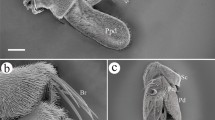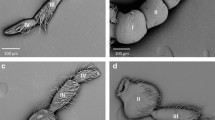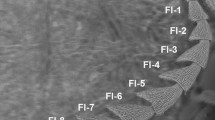Conclusion. Summary
Morphological and statistical researches on the sensory equipment of the Ant's antennæ in chapter I of this work have enabled us to interpret some biological phenomena to be enlarged upon in the next chapters.
The part played by the champagne cork shaped organs in the trophallaxic behaviour has been shown by ablations ofMyrmica lævinodis Nyl. antennæ.Aphænogaster gibbosa Latr., a species which does not practise the stomodeal exchanges, possesses twice less numerous champagne cork shaped organs on its antennæ.
Besides, in those mixed colonies where the two species are bred together,Aphænogaster sometimes receives food fromMyrmica.
However the importance of those needful organs should hot be overvalued becauseMyrmica is partly able to practise the trophallaxic behaviour whithout its feelers. Moreover, ifAphænogaster does not exchange food in its nests, this is certainly not due to a defect of its sensory equipment but very likely to the disappearance of the innate behaviour of «agiver», an inductor of the one of a «receiver». ThusAphænogaster's sensory equipment does need to become as evolued as the one ofMyrmica. The importance (very likely of an olfactory nature) of those organs in other behaviours may have caused its persistence onAphænogaster's antennæ. The crop of that ant has grown much less extensible than the one ofMyrmica.
It is further to be noticed that the behaviour ofMyrmica as agiver when its feelers have been cut-off proves easier to carry out but more difficult to acquire or to preserve on the evolutive plane, and thus seems to be more basic as regards trophallaxy.
Finaly, beyard the knowledge of the sensory qualities, the interest of the myrmecological material lies in that it affords a new method of approach for the study of the determinism of the behaviour.
Similar content being viewed by others
Bibliographie
Branton-Hicks (J.), 1859. — Further Remarks on the Organs of the Antennae of Insects, described in a paper published in the «Transactions of the Linnean Society»,XXII, p. 155.Trans. Linn. Soc.,22, p. 383–399, pl. 67.
Child (C. M.), 1894. — Ueber ein bisher wenig Beachtetes Sinnesorgan der Insekten mit besonderer Berückssichtigung der Culiciden und Chironomiden.Zeit. f. Wiss. Zool. (Leipzig),58, p. 475–528.
Delage (B.), 1968. — Recherches sur les Fourmis moissonneuses du Bassin Aquitain. Ethologie, physiologie de l'alimentation.Ann. Sc., Nat., 12e sér.,10, 2, p. 197–265.
Delage, (B.) etJaisson (P.), 1969. — Etude des relations sociales chez des Fourmis du genre Aphænogaster.C. R. Acad. Sc., Paris,268, p. 701–703.
Dostal (B.), 1958. — Riechfähigkeit und Zahl der Riechsinneselemente bei der Honigbiene.Zeit. Vergl. Physiol.,41, p. 179–203.
Fielde (A. M.), 1901. — Further study of an ant.Proc. Acad. Sc. Philad.,53, p. 521–544.—Fielde (A. M.), 1903. Artificial mixed Nests of Ants.Biol. Bull.,5, 6, p. 320–325.—Fielde (A. M.), 1904. On the artificial creation of mixed Nests of Ants.Biol. Bull.,6, 5, p. 326.
Forel (A.), 1874. — Les Fourmis de la Suisse.Nouv. Mém. Soc. Helv. Sc. Nat., Zurich,26, 447 p., 2 pl.—Forel (A.), 1885. Etudes myrmécologiques en 1884 avec une description des organes sensoriels des antennes.Bull. Soc. Vaud.,20, p. 316–380, pl. 11.
Grassé etChauvin (R.), 1944. — L'effet de groupe et la survie des neutres dans les Sociétés d'Insectes.Rev. Scient.,82, p. 461–464.
Heyde (H.), 1924. — Die Entwicklung der psychischen Fähigkeiten bei Ameisen und ihr Verhalten bei abgeänderten biologischen Bedingungen.Biol. Zentr.,44, p. 623–654.
Janet (C.), 1904. —Observations sur les Fourmis. Limoges, Ducourtieux et Gout, 68 p., 7 pl., 11 fig.
Kaissling (K. E.) etRenner (M.), 1968. — Antennale Rezeptoren für Queen substance und Steszelduft bei der Honigbiene.Zeit. Vergl. Physiol. Dtsch.,59, 4, p. 357–361.
Kraepelin (K.), 1883. — Ueber die Geruchsorgane der Gliedertiere.Progr. Realsch. Johan. Hamburg. Ostern, 48 p., 3 pl.
Krause (A. H.), 1907. — Die antennalen Sinnesorgane der Ameisen in ihrer Zahl Verteilung bei den Geschlechtern und Individuen einiger Arten.Inaug. Dissert. Jena. Gust. Fischer, 40 p., 8 fig.
Kuwabara (M.) etTakeda (K.), 1956. — On the hygroreceptor of the Honeybee.Apis mellifica. Physiol. Ecol., Kyushu Univ.,7, p. 1–6.
Lamotte (M.) 1957. —Initiation aux méthodes statistiques en biologie. Masson et Cie, édit., Paris.
Le Masne (G.), 1951. — Echanges de nourriture, trophallaxie et transports mutuels chez les Fourmis.Traité de Zoologie de P. P. Grassé,10, 2.
Leydig (F.), 1860. — Ueber Geruchs und Gerhörgane der Krebse und Insekten.Archiv. Anat. Physiol. Wiss. Méd.,265, p. 314, pl. VII–IX.
Lubbock (SirJ.), 1877. — On some Points in the anatomy of Ants.Month. Micr. Journ.,1, p. 121–142, pl. 189–192.—Lubbock, (Sir J.), 1883.Fourmis, Abeilles et Guêpes. Etudes expérimentales sur l'organisation et les mœurs des Sociétés d'Insectes Hyménoptères. In: Bibliothèque scientifique internationale, 2 vol.
Schenck (O.), 1903. — Die antennalen Sinnesorgane einiger Lepidopteren und Hymenopteren mit besonderer Berücksichtigung der sexuellen Unterschiede.Zool. Jahrb. Anat. Ontog. Tiere,17, p. 573–616.
Slifer (E. H.), 1958. — Specialized areas on the body Surface of grasshoppers and locusts.Proc. Intern. Congr. Entom., 10th Montreal, 1956,1, p. 531–534.—Slifer (E. H.) 1961. The fine structure of Insect sense organs.Intern. Rev. Cytol.,11, p. 125–159.
Snodgrass (R. E.), 1926. — The morphology of Insect sense organs and the sensory nervous system.Smith. misc. coll.,77, p. 1–80.
Stumper (R.), 1962. — Sur un effet de groupe chez les femelles deCamponotus vagus Scop.Insectes Sociaux, Paris,9, 4, p. 329–333.
Verron (H.), 1963. — Rôle des stimulis chimiques dans l'attraction sociale chezCalotermes flavicollis Fabr.Insectes Sociaux, Paris,10, 4, p. 297–336.
Von Frisch (K.), 1918. — Ueber den Gerchsinn der Biene und seine Bedeutung für den Blumenbesuch.Verh. zool. bot. Ges. Wien,68, p. 129.—Von Frisch (K.), 1921. Ueber den Sitz des Geruchsinnes bei Insekten.Zool. Jahrb. Abt. Allgem. Zool. Physiol. Tiere,38, p. 449–516.
Wheeler (W. M.), 1910. — Ants, their structure, development and behavior.Colum. Biol. sér.,9.—Wheeler (W. M.), 1918. A study of some Ant larvae, with a consideration of the origin and meaning of social habit among Insects.Proc. Amer. Philos. Soc.,57, p. 293–343.
Author information
Authors and Affiliations
Additional information
Adresse au moment de la parution de l'article: Laboratoire d'Ethologie Expérimentale «Les Sources», 78-Mittainville.
Rights and permissions
About this article
Cite this article
Jaisson, P. Étude de la distribution des organes sensoriels de l'antenne et de leurs relations possibles avec le comportement chez deux fourmis myrmicines:Myrmica lævinodis Nyl. etAphænogaster gibbosa Latr. récoltées dans la région des Eyzies. Ins. Soc 16, 279–312 (1969). https://doi.org/10.1007/BF02309000
Issue Date:
DOI: https://doi.org/10.1007/BF02309000




